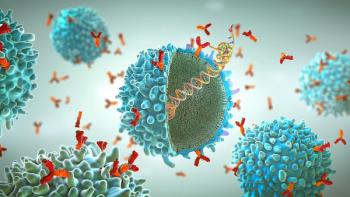
FDA Grants Breakthrough Therapy Designation to Bispecific ADC for EGFR-Mutant Lung Cancer
Key Takeaways
- Iza-bren targets EGFR and HER3, delivering a cytotoxic payload to tumor cells, potentially improving outcomes for advanced NSCLC patients with EGFR mutations.
- The FDA breakthrough therapy designation highlights iza-bren's potential to address unmet needs in NSCLC treatment, especially after resistance to current therapies.
Bristol Myers Squibb and SystImmune’s iza-bren shows promising efficacy and safety in EGFR-mutant NSCLC after TKI and chemotherapy, backed by data from global and China-based trials.
On Aug. 18, 2025, Bristol Myers Squibb and SystImmune, a US-based clinical-stage biotechnology company, announced that FDA has granted breakthrough therapy designation to izalontamab brengitecan (iza-bren) for treating locally advanced or metastatic non-small cell lung cancer (NSCLC) harboring specific epidermal growth factor receptor (EGFR) mutations (1). This designation applies to patients whose disease has progressed after treatment with both tyrosine kinase inhibitors (TKIs) and platinum-based chemotherapy, two of the current standards of care (2,3).
This designation marks an important regulatory recognition of a therapy that combines novel drug engineering strategies—bispecific targeting and payload delivery—against one of the most challenging oncology indications. “The FDA’s granting of breakthrough therapy designation underscores the potential of iza-bren to meaningfully improve clinical outcomes for patients with previously treated epidermal growth factor receptor mutation NSCLC,” said Jonathan Cheng, MD, chief medical officer, SystImmune, in a company press release (1).
Clinical need and therapeutic gap
NSCLC accounts for about 80% of all lung cancer cases and is the leading cause of cancer-related mortality worldwide. About 10–15% of patients in Western populations, and as many as half in Asian populations, carry activating EGFR mutations that initially respond to TKIs such as osimertinib. Resistance, however, is nearly inevitable, often within 18 months, leaving clinicians with platinum-based chemotherapy as the next line of therapy. The limited efficacy and considerable toxicities of this option underscore the need for alternatives (1).
“The data we have generated to date suggest that iza-bren could address a critical unmet need in patient care, and we look forward to working closely with [FDA] to conduct the relevant clinical studies and seek regulatory approval,” Cheng said in the release.
Bispecific ADC mechanism and development
Iza-bren represents a potential first-in-class bispecific antibody-drug conjugate (ADC) that simultaneously targets EGFR and human epidermal growth factor receptor 3 (HER3), two signaling pathways closely tied to epithelial cancer cell proliferation and survival. The therapy employs a dual mechanism that involves blocking both EGFR and HER3 signaling, while also delivering a topoisomerase 1 inhibitor payload directly into tumor cells. Once internalized, the drug conjugate releases its cytotoxic payload, which induces DNA damage and cancer cell death.
Clinical evidence supporting FDA’s decision came from three ongoing studies, consisting of two conducted in China by Sichuan Biokin Pharmaceutical and one global trial spanning the United States, Europe, and Japan under the direction of SystImmune. Across these studies, iza-bren demonstrated signs of improved efficacy along with a manageable safety profile in patients who had already received both third-generation tyrosine kinase inhibitors and platinum-based chemotherapy, according to Bristol Myers Squibb and SystImmune. The two companies are in a collaboration and exclusive license agreement to develop iza-bren outside of China (4). In China, iza-bren is being developed by Biokin.
Highlighting future therapeutic potential
Iza-bren highlights ongoing innovation in ADC engineering, where careful optimization of targeting specificity, linker chemistry, and cytotoxic payload can determine both efficacy and tolerability. If successful, this bispecific ADC approach may inform the design of next-generation ADCs beyond lung cancer.
References
1. Bristol Myers Squibb.
2. Jeon, H.; Wang, S.; Song, J.; et al.
3. Oncolibrary. Lung Cancer Chemotherapy Success Rate: What Patients Need to Know in 2025. oncodaily.com, Aug. 4, 2025 (accessed Aug. 18, 2025).
4. Bristol Myers Squibb.
Newsletter
Stay at the forefront of biopharmaceutical innovation—subscribe to BioPharm International for expert insights on drug development, manufacturing, compliance, and more.




